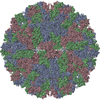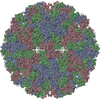+Search query
-Structure paper
| Title | Crystal structure of a nematode-infecting virus. |
|---|---|
| Journal, issue, pages | Proc Natl Acad Sci U S A, Vol. 111, Issue 35, Page 12781-12786, Year 2014 |
| Publish date | Sep 2, 2014 |
 Authors Authors | Yusong R Guo / Corey F Hryc / Joanita Jakana / Hongbing Jiang / David Wang / Wah Chiu / Weiwei Zhong / Yizhi J Tao /  |
| PubMed Abstract | Orsay, the first virus discovered to naturally infect Caenorhabditis elegans or any nematode, has a bipartite, positive-sense RNA genome. Sequence analyses show that Orsay is related to nodaviruses, ...Orsay, the first virus discovered to naturally infect Caenorhabditis elegans or any nematode, has a bipartite, positive-sense RNA genome. Sequence analyses show that Orsay is related to nodaviruses, but molecular characterizations of Orsay reveal several unique features, such as the expression of a capsid-δ fusion protein and the use of an ATG-independent mechanism for translation initiation. Here we report the crystal structure of an Orsay virus-like particle assembled from recombinant capsid protein (CP). Orsay capsid has a T = 3 icosahedral symmetry with 60 trimeric surface spikes. Each CP can be divided into three regions: an N-terminal arm that forms an extended protein interaction network at the capsid interior, an S domain with a jelly-roll, β-barrel fold forming the continuous capsid, and a P domain that forms surface spike projections. The structure of the Orsay S domain is best aligned to T = 3 plant RNA viruses but exhibits substantial differences compared with the insect-infecting alphanodaviruses, which also lack the P domain in their CPs. The Orsay P domain is remotely related to the P1 domain in calicivirus and hepatitis E virus, suggesting a possible evolutionary relationship. Removing the N-terminal arm produced a slightly expanded capsid with fewer nucleic acids packaged, suggesting that the arm is important for capsid stability and genome packaging. Because C. elegans-Orsay serves as a highly tractable model for studying viral pathogenesis, our results should provide a valuable structural framework for further studies of Orsay replication and infection. |
 External links External links |  Proc Natl Acad Sci U S A / Proc Natl Acad Sci U S A /  PubMed:25136116 / PubMed:25136116 /  PubMed Central PubMed Central |
| Methods | EM (single particle) / X-ray diffraction |
| Resolution | 3.25 - 6.9 Å |
| Structure data |  EMDB-5952:  PDB-4nwv:  PDB-4nww: |
| Chemicals |  ChemComp-CA: |
| Source |
|
 Keywords Keywords | VIRUS / beta barrel |
 Movie
Movie Controller
Controller Structure viewers
Structure viewers About Yorodumi Papers
About Yorodumi Papers



 orsay virus
orsay virus